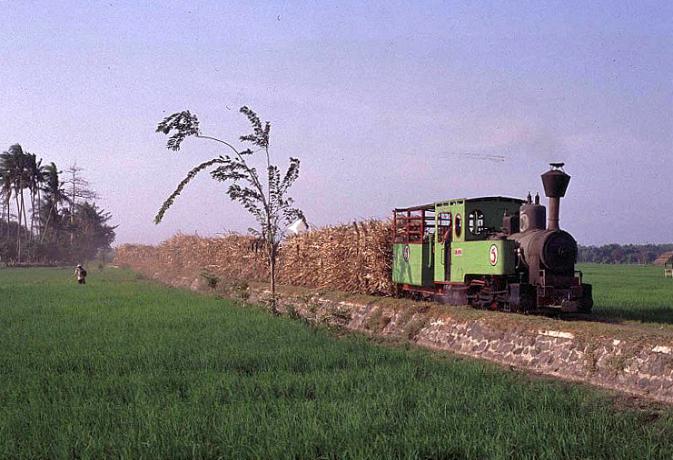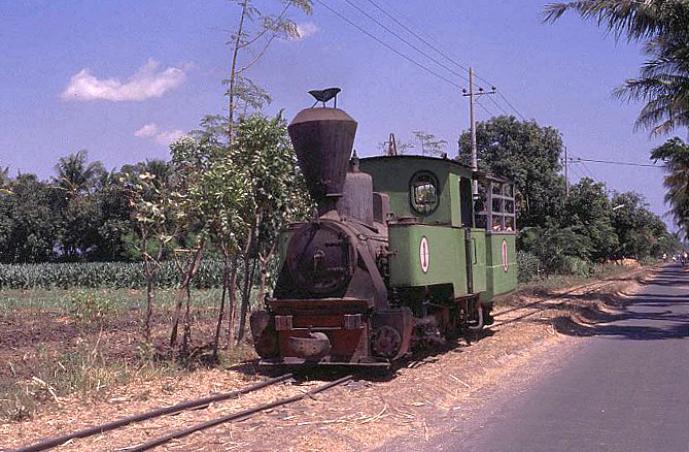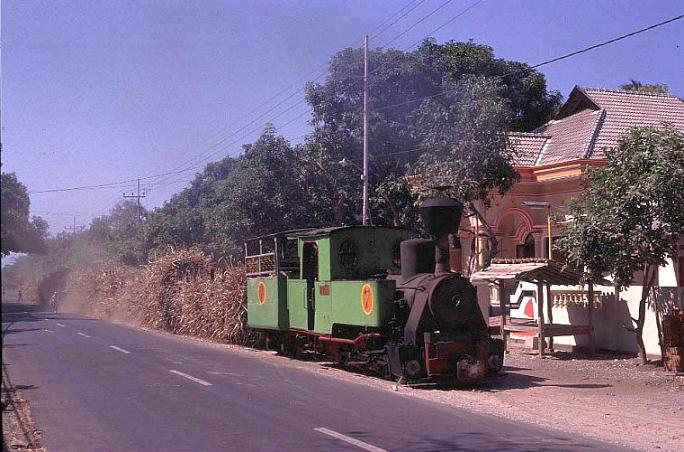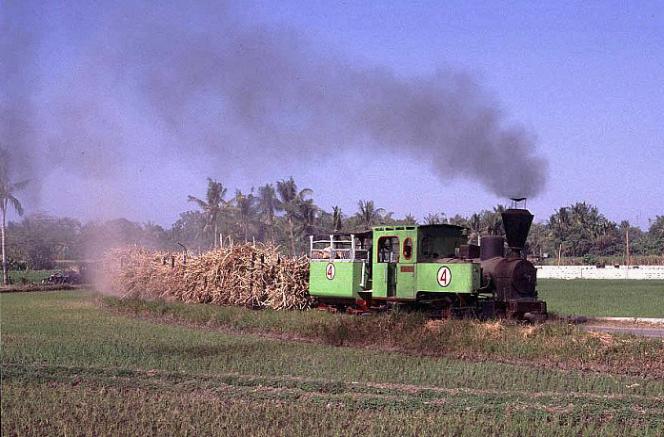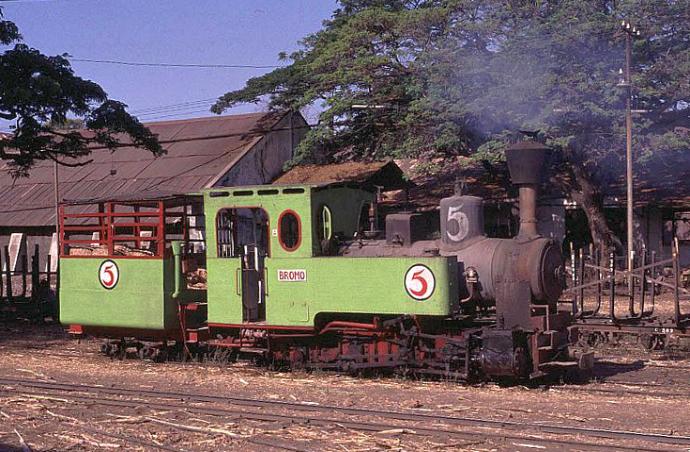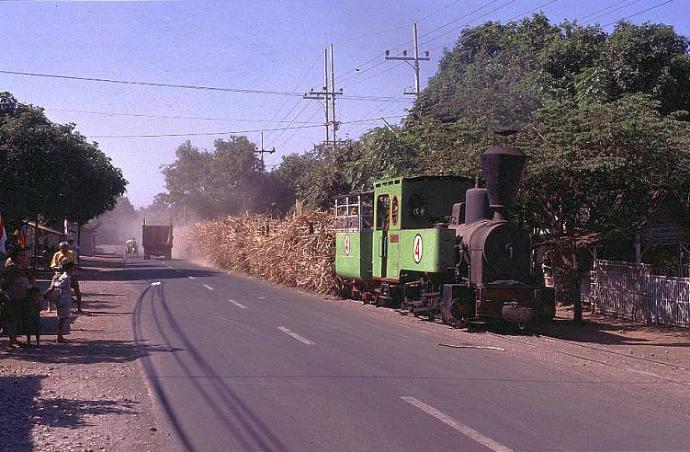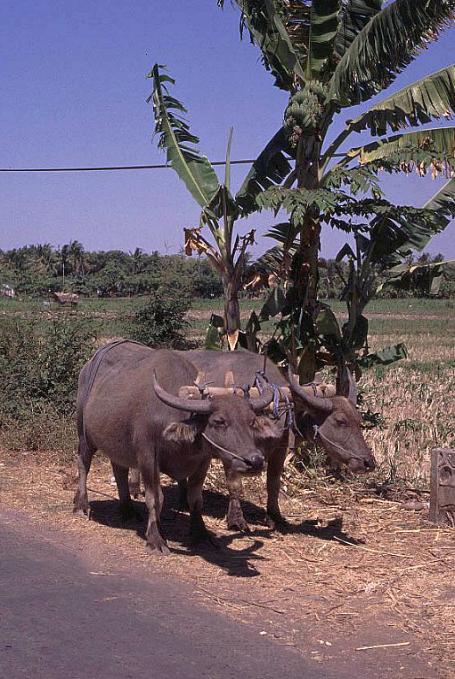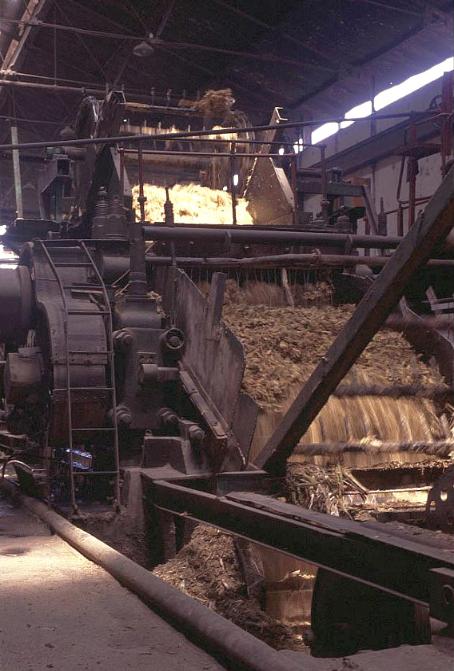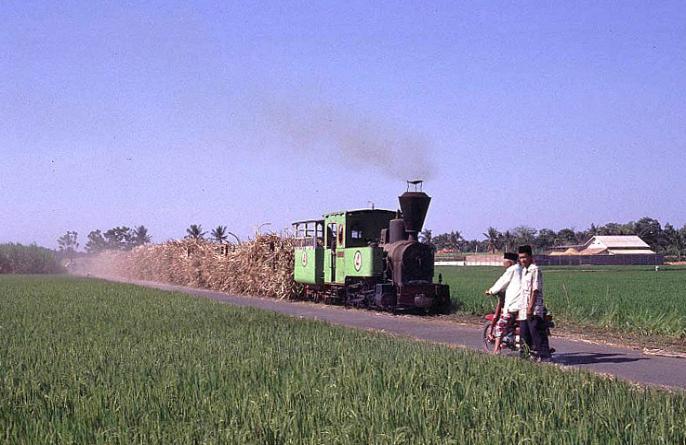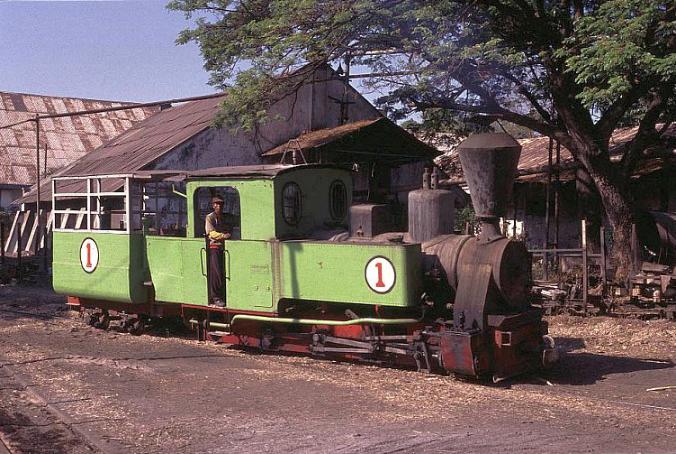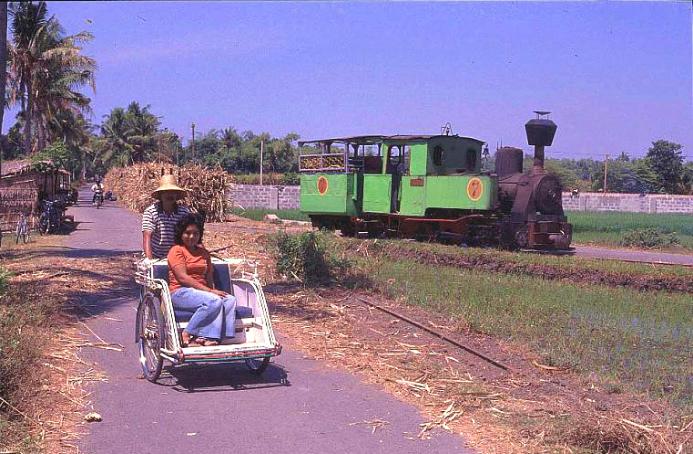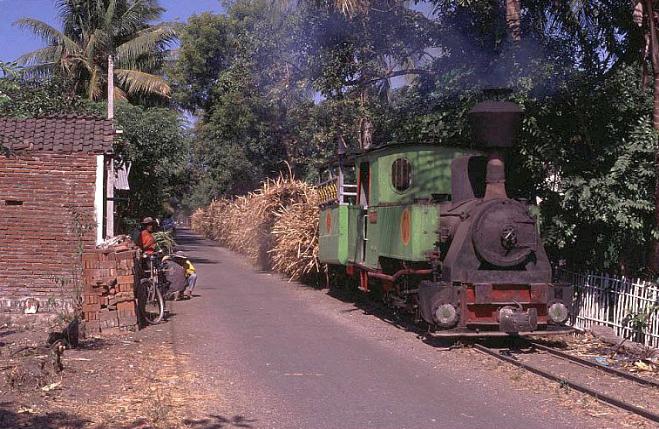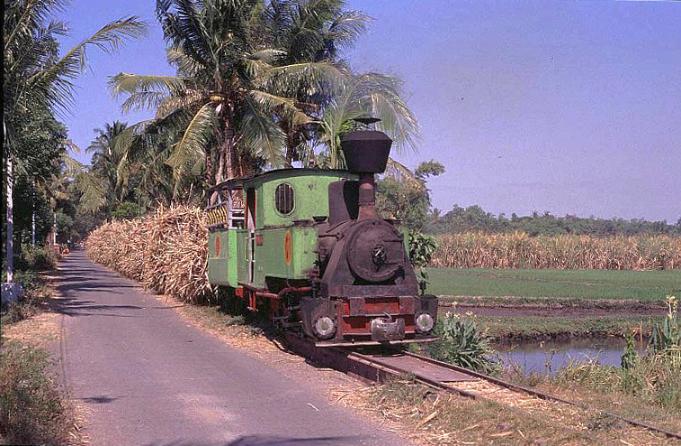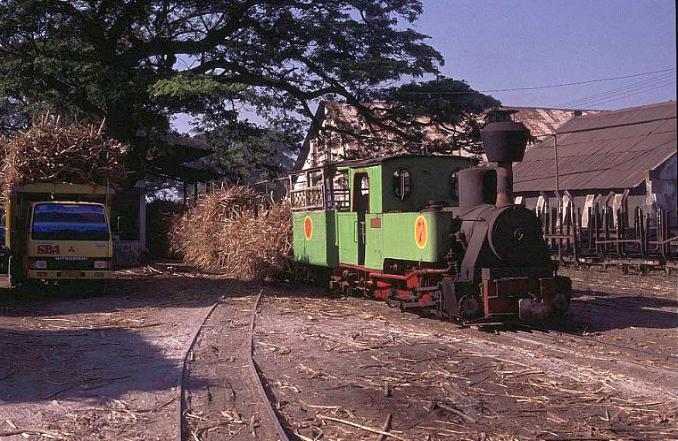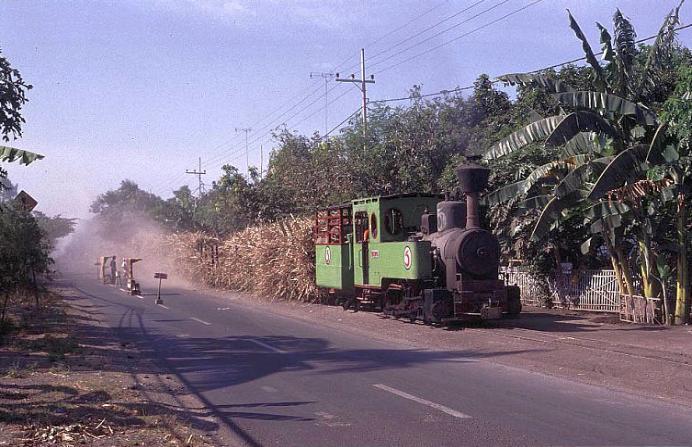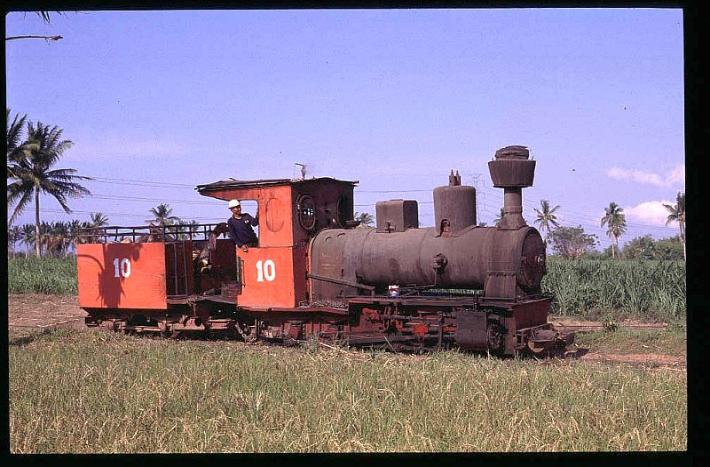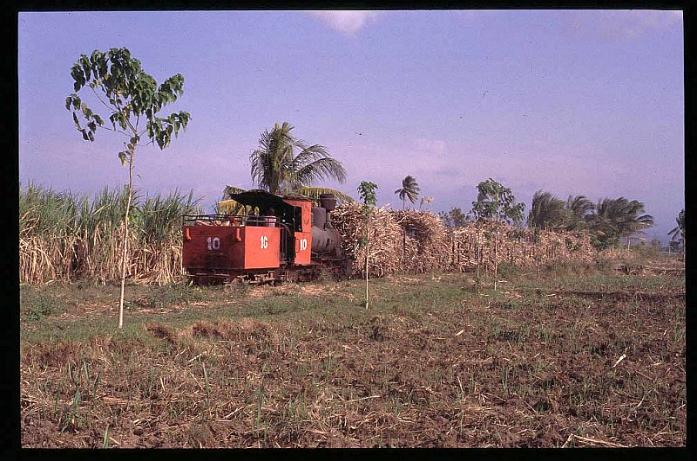| The inexorable rise of the diesel locomotive and the decline of steam means that opportunities to photograph steam hauled cane trains in Java has dramatically reduced. Not that it was ever easy - on many systems the returning trains of loaded wagons began their journeys back to the mills at sunset or even after dark although those with the knowledge managed to find daylight trains on certain systems. The start of the 2004 season saw the end of field trains at Sragi, leaving only Olean and Asembagus mills to carry on the tradition. Photographing cane trains on the move is fairly easy since their rate of progress is severely limited by the state of the track. Indeed at Olean it was possible to travel on the footplate of the locomotive, jump off the moving engine to run ahead of the train, take the photograph and get back onto the footplate again ready to move on to the next spot. Its certainly a great way to keep fit! The only downside from a photographic point of view is that the locomotives make very little smoke or 'clag' as the bagasse burns very cleanly. Therefore it is sometimes difficult to tell the difference between a photograph of a train which is on the move and one which is actually stationary! |
| If there is such a place as heaven for steam enthusiasts then it must be Olean. The mill is located at the eastern end of the island close to the city of Situbondo - where there are several perfectly adequate hotels - but for those in search of paradise the nearby beach resort of Pasirputih offers hotel rooms with balconies opening straight onto the beach, spectacular outrigger sailing boats for hire and dramatic views of the sun sinking into the ocean. A short bus trip into Situbondo and a leisurely ride in becak (cycle taxi) is an ideal preparation for a day of steam action. The mill itself has an incredible collection of stationary steam engines powering the mill machinery and it would be entirely possible to spend a whole day wandering around the various buildings. Early morning visitors are likely to find the locomotive depot deserted as the four Orenstein and Koppels will have already taken long trains of empty loris out to the fields running bunker-first. However by about 10.30 most of the engines have returned to the yard where they are prepared for the serious work of the day. From mid-day onwards the locomotives begin to leave the yard and head off light engine along the Gelung or Semiring lines to collect the loaded cane wagons. |
| Orenstein and Koppel 0-8-0T No.1 returns towards Olean having taken a train of empty cane wagons out to the fields near Gelung |
| The locos operate according to where the cane is being cut and during my visit the Semering line saw the majority of the activity with cane being cut very close to Olean mill on the other line - which also happens to face straight into the sun! Orenstein and Koppel No.7 'Hiyang' runs alongside the road through the village of Tribungan. |
| A rare display of smoke from Orenstein and Koppel No.4 'Semeru' as it comes round one side of the triangle between Tribungan and Karang Malang |
| No.5 'Bromo' standing in the main mill yard at Olean. As well as cane brought into the mill by the locomotives there is also a continuous stream of lorries offloading in the adjacent sidings - a potentially ominous sign for the future of rail operation at the mill. |
| Another day and another train passing through Tribungan - this time it is No.4 'Semeru' which is attracting the interests of the locals as it makes its way back to Olean. |
| Although the main railway tracks are permanent it is necessary to get the cut cane from the fields to the line. To do this temporary tracks are laid across the fields and the loaded loris brought to the main line by means of buffalo traction! Teams of four, six or even eight buffalo are used to pull one or two wagons. (above left) Inside the mill the cane is firstly chopped, washed and then gradually crushed to extract the sugar from out of the cane. Much of the machinery inside the mill is still steam powered by large stationary engines of Dutch or British origin (above right) |
| The bemused look on the face of the local says it all having just watched me jump from the footplate of No.4 and run along the road in order to get a shot of the train running alongside the road just north of Karang Malang. |
| Orenstein and Koppel No.1 stands in the main yard at Olean having just brought in a train of loaded wagons from Duwet on the Gelung branch |
| The becak is a standard means of travel in many villages, towns and cities across Java. The becak riders are willing to travel quite long distances and it is an excellent way to observe local life at a leisurely pace. Here a becak passes No.7 as it waits to move wagons near Tribungan |
| Having run alongside the road through the village of Tribungan the line then crosses the road and turns west, running along a narrow lane towards Karang Malang - scenes like this and the one below make Olean totally unforgettable. |
| Having taken the shot above I elected to stay on foot and run on ahead of the train. With legs turning to jelly and lungs fit to burst I was just about capable of photographing No.7 as it crossed a tiny river bridge between Tribungan and the triangle north of Karang Malang. |
| Journey's end as No.7 brings its train across the weighbridge at Olean. I had enjoyed an entire afternoon on the footplate of the locomotive and all for the price of a couple of packets of local cigarettes. To my way of thinking, avoiding corrupting the local goodwill and ensuring that the practices of the working railway are in no way compromised is essential. Working steam in C21st is an endangered species and needs to be treated with care and respect. |
| No one can be certain how much longer scenes like this will continue to be enjoyed. The falling price of sugar on the world markets makes the future of the industry uncertain and the steady inroads made by the diesel salesmen adds to the pressure on steam. In 2005 at least it has still been possible to see No.5 hard at work but who knows what the future holds for Olean .........? |
| Asembagus Located some 20km to the east of Situbondo is Asembagus mill. This is the only other mill in Java which still regularly uses steam to collect cane from the fields during daylight although trains are far less reliable than at Olean with some days seeing no steam action at all. I waited for most of the day before an engine left the mill to collect loaded wagons and chose to ride the locomotive to take my pictures. After a pleasant run of some 6 - 7km we found the loaded wagons and I took up position ready to make my shots. The driver opened the regulator .... and with a sickening crunch the rails under the locomotive collapsed sideways! With no chance of the engine being re-railed before sunset I resigned myself to a long walk back to the mill but fortunately managed to find a young man working in one of the trackside fields who had a motorbike ............. and the natives are very helpful! |
| Orenstein and Koppel 0-8-0T No.10 standing in the fields at Asembagus. This locomotive is something of a hybrid with the frames of one locomotive being paired with the boiler of another to create a 'new' engine |
| No.10 stands at the head of its train ready to haul the loaded wagons back to the mill. Just a few seconds after this shot was taken, disaster struck (see above) and it was game over at Asembagus! |
| Orenstein and Koppel 0-8-0T No.5 'Bromo' returning home on the Semiring line just north of Karang Malang on the Olean mill system on 20th August 2004 (below) |


| OLEAN EASTERN MILLS |
